Watering & Conservation
Conservation
As the North Central Texas region continues to grow, having enough water to meet our demands will become a major issue. Many local governments have imposed voluntary or mandatory restrictions on outdoor water use to encourage water conservation throughout the region. One of the principles of SmartScape is to promote native and adapted plants for this region that require less water. Native and adapted plants use 80% less water and tolerate our heat!
While it is important for you to select plants, trees and grasses that have lower water requirements, you also need to know how to water the landscape for conservation purposes. Here are some simple tips that can help you conserve water this season.
First, know if your community has water restrictions in place. Remember the water you use to irrigate your landscape is also your family's drinking water supply.
Check with your local water utility about any voluntary or mandatory measures in place. Each city in our region sets its own individual water conservation plan, so visit your city's web site or call your water utility to learn what specific restrictions apply to your city.
Know the stages of drought and follow any advisories set by your community.
- Stage 1 - slight drought
- Stage 2 - moderate drought
- Stage 3 - severe drought
How to water efficiently and effectively
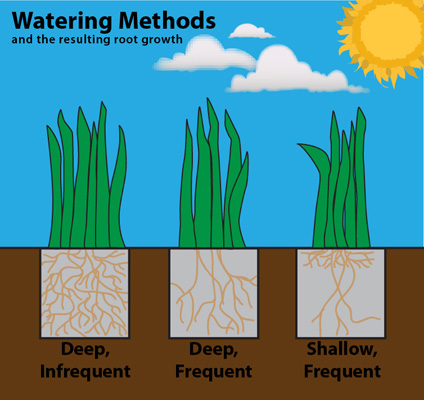 Let's start with the way that plants absorb water, which is through the roots. Plant roots are opportunistic. They will grow where there is water.
Let's start with the way that plants absorb water, which is through the roots. Plant roots are opportunistic. They will grow where there is water.
Deep infrequent watering creates deep roots. Shallow frequent watering creates short roots. As water evaporates from the soil surface, short-rooted plants and lawns will need water more often.
Deep-rooted plants and lawns will be able to absorb water from the deeper soil, over a longer period of time. If your city or water supplier were to declare a 5-day outdoor watering restriction or ban, which type of plant/root system would survive and thrive?
Develop deep roots. Deep, infrequent watering helps plants thrive.
Deep infrequent watering creates deep roots, which helps plant to absorb water from the deeper soil over a longer period of time. This approach also reduces disease, helps ensure good air movement down to the root system, and conserves water.
Water lawns slowly, allowing water to reach a depth of 6 inches. Avoid shallow frequent watering, which creates short roots. As water evaporates from the soil surface, short-rooted plants and lawns will need water more often.
Measure how much water you're placing on the lawn to ensure you aren't watering too much! Use a tuna can or something similar and time how long it takes for one inch of water to fill the can.
Avoid runoff by adjusting watering duration, volume of spray heads or direction of sprinkler/spray heads.
When to water makes a difference
50-60% of your irrigation can be lost to evaporation. Whenever possible, water between midnight and 8:00 am; early morning is best to avoid evaporation. Most cities have implemented strict watering guidelines, so check to see these guidelines before you water your lawn or landscape. Water requirements differ for each plant, but the general rule to follow is check the soil moisture level before you water. If only a small area is dry with the rest moist, try hand watering just the dry spots with a hose, instead of turning on the automatic sprinkler system. Use the Texas ET Network to determine the potential water needs in accordance with the weather conditions.
Don't water in the rain, that's just wasteful. Install a rain sensor on irrigation systems to prevent waste.
Tips for Lawns
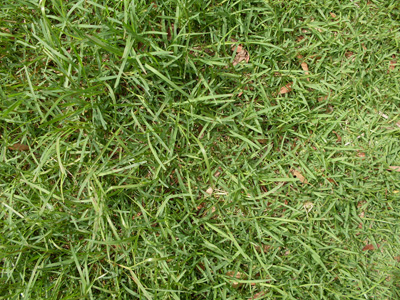 Know when your lawn needs water by careful observation, not simply because you have a set schedule or an automatic sprinkler system.
Know when your lawn needs water by careful observation, not simply because you have a set schedule or an automatic sprinkler system.
Maintain a deep, infrequent watering schedule. This approach is best for the overall health of the lawn. It allows your grass to develop deep root systems, reduces disease, helps insure good air movement down to the root system, and conserves water. The most common warm season grasses for our area (St Augustine, Zoysia, and Bermuda) all can benefit from this watering approach. Good soil health is crucial for efficient watering, as well as efficient sprinkler systems.
Tips for maintaining moisture
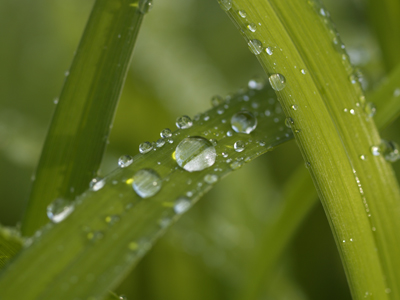
- If you plan to install new landscaping, prepare your beds now with plenty of mulch.
- Use at least 3-6" of organic mulch in all flower, shrub and garden bed areas to reduce watering frequency.
- Leave grass clippings on the lawn to help maintain moisture.
- Water trees separately by placing a soaker hose under the outer ring of branches and let the hose drip for several hours, as needed.
- Daily drip irrigation or hand watering may be needed for some containerized plants.
Watering to establish new plants
Water the plant, water the hole, water the plant in the hole.
"Water the plant, water the hole, water the plant in the hole" is an effective rule of thumb when transplanting. Watering the new plant before removing it from its container helps the soil stick to the roots while ensuring that the root ball is well-irrigated and all the available roots have moisture. Watering your newly dug hole allows you to check for any drainage problems that you might need to correct, ensures that the surrounding soil is moist, and reduces the possibility of water being wicked away from the new plant's root ball into surrounding soil. Watering the plant in the hole after it has been transplanted helps the root ball and surrounding soil to settle and reduces the number of air pockets.
How can I tell how long to water a plant to get it established?
How long depends on the type of irrigation you are using: automated sprinklers, drip lines, or hand watering. Rather than going by a set time, a better guideline is to keep the soil evenly moist throughout the entire growing season. "Even moisture" is best tested by sticking your finger or a screwdriver about an inch into the soil near the base of the plant. Why the base? The root ball dries at a different rate than the surrounding soil. It should be detectably moist but not wet; you don't want to overwater, either. If your finger or screwdriver is dry, it's time to water. Still not sure? Invest in and use a moisture meter.
Rainwater is free and better for your plants than tap water.
Rainwater is free, and it's better for plants than chemically treated water, as it doesn't contain the chlorine, lime, or calcium that can be detrimental to plant health over time. Downspouts can easily be diverted into a rain barrel to store rainwater. The collected rainwater can be used to irrigate lawns, gardens, flowerbeds, and trees. When you divert rainwater from your downspouts, you are also reducing the amount of flow to storm drains and potentially reducing water pollution from stormwater runoff. Rain barrels can be purchased at many local home improvement stores, online, or they can be easily and cheaply built with readily available materials.
Learn more about rainwater harvesting:
- Guide to Yard Care (Take Care of Texas)
- Rainwater Harvesting (Take Care of Texas and Texas A&M AgriLife Extension)
- Training Programs (Texas A&M AgriLife Extension)
Automatic Sprinklers
Today, more than half of the newly built homes come with an automatic sprinkler system pre-installed. Additional systems are installed by some homeowners after moving in. Added to this total are the many existing homes that are being retrofitted with automatic sprinkler systems. That is a lot of automation!
These systems are popular because they are a real time saving convenience and they supply large areas of a landscape with plenty of water. With careful timing of zone watering and proper selection of spray nozzles, these systems can be adjusted to water in a reasonably efficient manner, e.g. when plants need the water.
 Monitor the zone settings and adjust throughout the year to meet changing weather conditions and landscape needs. This is an ongoing task that many don't know about, forget about or choose to ignore. If settings are not monitored and changed, at some time during the growth season a landscape will be either under or over watered. Over watering is especially easy to do if the system does not have a rain sensor, which will keep it from applying water during and after a storm. Rain sensor switches are available at home and garden centers, plumbing/irrigation suppliers, etc., for approximately $25.
Monitor the zone settings and adjust throughout the year to meet changing weather conditions and landscape needs. This is an ongoing task that many don't know about, forget about or choose to ignore. If settings are not monitored and changed, at some time during the growth season a landscape will be either under or over watered. Over watering is especially easy to do if the system does not have a rain sensor, which will keep it from applying water during and after a storm. Rain sensor switches are available at home and garden centers, plumbing/irrigation suppliers, etc., for approximately $25.
Note: Please be aware that you can damage and kill plants by over watering, especially low-water use native and adapted plants. Some ways to help minimize over watering include the routine monitoring and adjustment of your system, installing a rain sensor switch and manually operating the system.
Sprinkler Runoff
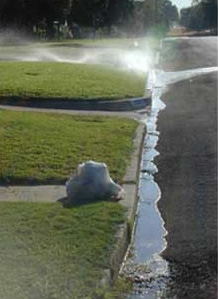 No matter how much you water it, concrete will not bloom! Save the water for your plants.Runoff occurs when water leaves your property by flowing over curbs or into streets. This wasted water will not benefit your landscape or pocketbook. There are two common causes of runoff, which you can control fairly easily.
No matter how much you water it, concrete will not bloom! Save the water for your plants.Runoff occurs when water leaves your property by flowing over curbs or into streets. This wasted water will not benefit your landscape or pocketbook. There are two common causes of runoff, which you can control fairly easily.
The first is spraying water on concrete or asphalt surfaces such as sidewalks and driveways that lead directly to the street. Installing or aligning adjustable spray heads/hose sprinklers will fix this.
The second cause is watering at a rate faster than the ground can absorb it. Many water sprinkler systems have high volume heads that apply water at a rate faster than the ground (especially clay soils) can absorb it. Fix this by installing sprinkler heads that apply less water or by running each station several times for a shorter period of time.
Drip Irrigation
Drip irrigation systems are very efficient (use up to 60% less water) at supplying water to smaller areas of a landscape. These systems are based upon the fact that plant roots stay in an area that has sufficient water. Drip irrigation places a small amount of water (and, as an option, nutrients) close to the roots. Almost 95% of drip irrigation water can reach a plant, while traditional automatic sprinklers are much less efficient. If you've not considered drip irrigation before, talk to your contractor or landscaper about it. You can also check out the do-it-yourself systems available at garden and home improvement centers.
Even if you already have or are going to install an automatic sprinkler system, drip irrigation can be added to it. Using a retrofit kit, any individual sprinkler riser can be replaced with a drip irrigation head. The head contains up to 12 connections for dripper tubes. These tubes are then routed to different areas or plants.
Another inexpensive drip irrigation system is a hose kit that attaches to a faucet (with a back-flow preventer). Using a simple tool provided in the kit, position the hose and attach dripper buttons, emitters, etc. wherever you need them.
The simplest and least expensive example of drip irrigation is the use of soaker hoses. These are especially useful in flower beds and around trees. They can also be placed next to the house to stabilize soil next to the foundation.
Note: When using them, turn the faucet only a quarter of a turn. Soaker hoses are pressure sensitive, if the pressure is too high, water flows through them like an open hose. Check them every 30 minutes until the water has soaked to the desired depth (usually 6 inches). Use a garden trowel to dig into the soil to see how deep the water has penetrated. Once you have the timing down, this will be an easy way to use drip irrigation.
Mirar el video en español: La Conservación Del Agua Y El Mantenimiento De Riego
Hand Watering
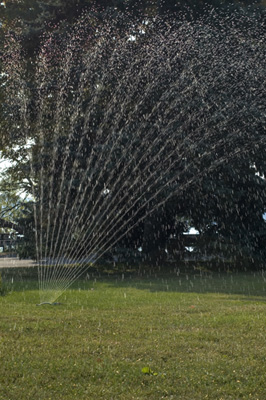 Hand watering means using a combination of hose end yard sprinklers that have to be moved and the use of a handheld hose.
Hand watering means using a combination of hose end yard sprinklers that have to be moved and the use of a handheld hose.
For most applications, the first thing to consider is using a sprinkler that does not produce a fine mist. Fine mist evaporates more quickly and is easily blown out of the area you want to water. When using a sprinkler on your lawn, be sure that you deliver the amount of water needed. For specific information about watering lawns refer to the general watering section.
Once you know how long to leave the sprinklers running, you should get a faucet timer that will automatically shut off the sprinklers at the time you select. Since forgetting to turn off a faucet is pretty easy to do (personal experience), the timer will keep you from over watering lawns and plants as well as wasting water. There are both manual and electronic timers from which to choose.
If you have many outdoor containerized plants in your landscape, you will be spending a considerable amount of time keeping them watered (probably by hand) during the hot Texas summers. You may want to consider alternatives such as drip irrigation.
Tip: If you spot Texas SmartScape at a public event or come to one of our plant sales,
we usually hand out water gauges and moisture meters for free!
